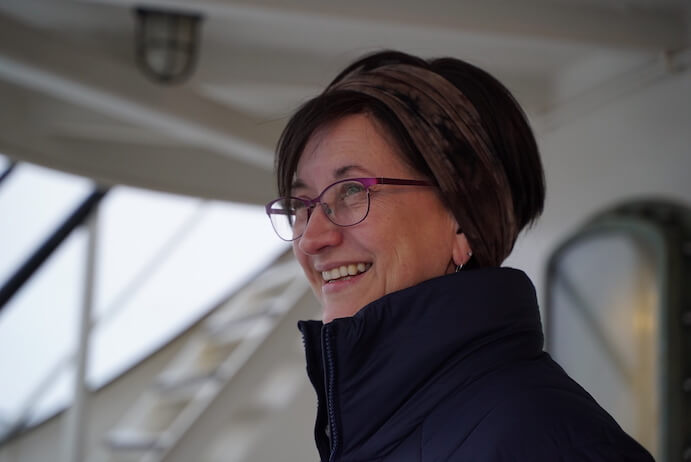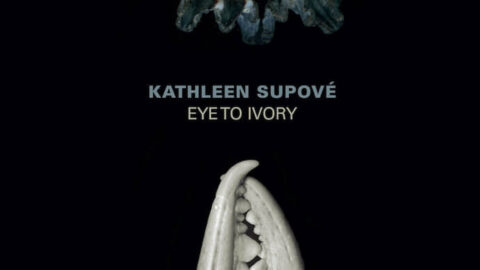Eye to Ivory (Starkland) is the newest in a line of full-length albums devoted to contemporary piano repertoire by piano superstar Kathleen Supové. If one desires fresh sounds on an instrument as revered as the piano, look no further than the impressive discography of Supové. Discovering new music in the era of the internet has never been easier, but to continually press forward in the world of the piano is an impressive feat. Eye to Ivory presents the premiere recordings of five relatively new compositions (all written within the past two decades) by composers Mary Ellen Childs, Guy Barash, Nick Didkovsky, Randall Woolf, and Dafna Naphtali. The five compositions featured on Eye to Ivory present a diverse range of sounds, featuring electronics, extended techniques, theatrics, vocalizations (both disturbing and jovial), and the Yamaha Disklavier.
The title track of the album, Mary Ellen Childs’ Eye to Ivory (2005), is a 15-minute long journey through the piano, emerging from the unsure undulations of the lowest notes, raucously stomping and angrily plodding through the keyboard in various contrasting sections. One becomes intimately aware of the space and openness of the extremities of the piano as clusters resonate into the void of space and silence and Supové explores the inner workings of the instrument by strumming the stings, providing layers of timbre and depth of sound. The inherent physicality of playing the piano is on full-display as one listens to this work, its kinetic energy infects the ears, and one can almost feel the exhaustion from the energy dispelled in Childs’ composition. From the intensely hammered and resonate clusters to the swaying of melodic middle section, this composition is a pianistic journey displaying Supové’s virtuosity from start to finish.

Guy Barash’s Talkback IV (2010/2012) for piano and computer is the fourth in a series of compositions by Barash for solo instruments and realtime digital signal processing. A modern version of Mario Davidovsky’s Synchronisms series, Barash’s Talkback series explores “extended techniques, enhanced timbre, and other sonic features characteristic of the instrument, by magnifying and amplifying otherwise subtle nuances and bringing them to the foreground.” One challenge in listening to a composition with computer processing elements is the lack of the visual component that is present in a live performance or video recording. It is quite difficult to discern what is coming directly from the piano as an acoustic sound versus what is a result of the processing, and this clarity is often provided when witnessing a live performance. The work is intended as a commentary on internet communications, and one can hear how excerpts of the piano line is copied, twisted, perverted out of context and shouted over the piano’s voice. It is a fascinating composition, and despite the shortcomings of a recorded experience, I find myself more motivated to seek out a live concert of Supové performing this work.
Nick Didkovsky’s Rama Broom (2000) takes us into a “homicidal fantasy,” where a poem chosen by Supové and set by Didkovsky slowly unveils its violent meaning, unfolding from simple words and syllables into contextually horrific imagery. Much like driving past a bad car accident, we cannot look away, or rather turn our ears away from this dramatic presentation. Supové’s emotionless voice is juxtaposed with passionate piano playing in a sociopathic combination of sounds. This composition and performance are fascinatingly brilliant.
After such a horrifically dreadful subject matter, a dramatic change of mood is needed. In The Privacy Of My Own Home (2000) by Randall Woolf, Supové’s spouse, explores the intimate nature of a relationship, showcasing the subtle, and sometimes not so subtle, variances of Supové’s laugh recorded, sampled, and controlled by Supové in a series of nine miniatures. Each movement accompanies a different style of laughing with an accompanimental, and sometimes contrasting, piano composition. Woolf weaves the piano around the humorous interjections, presenting each in a fresh perspective. I found myself hyper-aware of the contour of my own laugh for a 24-hour period after experiencing this composition.

Dafna Naphtali’s Landmine (1999-2007) for Disklavier and live processing, the last work on the album, is a four-movement work that was a performative collaboration with the composer, who controlled the live digital processing we hear in the composition. While the listening experience is incredible, the process through which this work was derived is even more fascinating: Naphtali created a computer-based algorithmic process that generates musical material, and uses this algorithm to play the Disklavier at times, fighting against the performer in an improvisatory battle of human vs. machine. The first movement, “a append,” opens with an energetic ostinato on an incessant repeated E, unfolding into larger and more involved interjections by both the pianist and the electronics. In the second movement, “xp swap,” the algorithm takes a more confrontational approach to the piano, battling for importance in the high frequencies while the piano attempts to ignore and press on in its own pointillistic fashion. The third movement, “:sh invoke a shell,” is a duo with the algorithm, both contributing to the others expressive musicality. In the final movement, “:q! quit without saving,” an improvisation battle is waged between Supové and computer, putting on full-display Supové’s musical prowess and control of the piano.
Eye to Ivory deserves a complete listening from all fans of new music and those who love the piano. This fresh approach to the repertoire inspires new perspectives and challenges the listener to introspectively review their own relationship with sound. It is a contrastingly complete product, each work exploring a different aspect of the human psyche and 21st century human experience. Take an hour, sit back, and give this an uninterrupted listen.
























